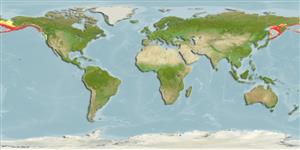Actinopterygii (ray-finned fishes) >
Scorpaeniformes (Scorpionfishes and flatheads) >
Cottidae (Sculpins)
Etymology: Myoxocephalus: Greek, myos = muscle, and also, mouse + Greek, kephale = head (Ref. 45335).
Environment / Climate / Range
Ecology
Marine; demersal; amphidromous (Ref. 51243); depth range 0 - 775 m (Ref. 6793). Temperate, preferred ?; 66°N - 42°N, 144°E - 124°W
North Pacific: Hokkaido, Japan and Kamchatka, Russia through the Aleutian Islands to the Bering Sea coast of Alaska and Puget Sound, Washington, USA.
Length at first maturity / Size / Weight / Age
Maturity: Lm ?, range 54 - 58 cm
Max length : 80.0 cm TL male/unsexed; (Ref. 56527); max. published weight: 9.0 kg (Ref. 56527)
Dorsal
spines
(total): 9 - 10;
Dorsal
soft rays
(total): 13-16;
Anal
spines: 0;
Anal
soft rays: 11 - 13. Caudal fin slightly rounded (Ref. 6885). Color deep olive on dorsal surface with 4 dark saddles across back; ventral surface pale; brown bars running downward on relaxed unpaired and paired pectoral fins (Ref. 6885).
Occurs in the intertidal area and to 244 m depth, on sand and mud bottoms (Ref. 2850). Feeds on small fishes (Ref. 4925). Often caught near shore (Ref. 2850).
Life cycle and mating behavior
Maturity | Reproduction | Spawning | Eggs | Fecundity | Larvae
Eschmeyer, W.N., E.S. Herald and H. Hammann, 1983. A field guide to Pacific coast fishes of North America. Boston (MA, USA): Houghton Mifflin Company. xii+336 p. (Ref. 2850)
IUCN Red List Status (Ref. 115185)
CITES (Ref. 94142)
Not Evaluated
Threat to humans
Harmless
Human uses
Fisheries: commercial
More information
ReferencesAquacultureAquaculture profileStrainsGeneticsAllele frequenciesHeritabilityDiseasesProcessingMass conversion
Tools
Special reports
Download XML
Internet sources
